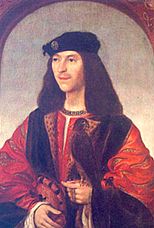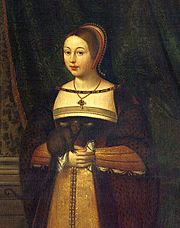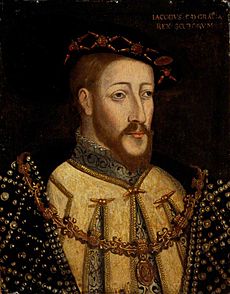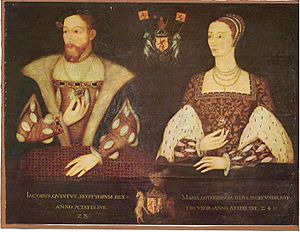James V of Scotland facts for kids
Quick facts for kids James V |
|
|---|---|
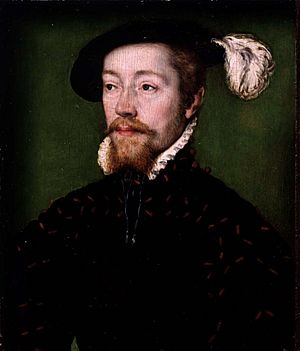
Portrait by Corneille de Lyon, c. 1536
|
|
| King of Scotland | |
| Reign | 9 September 1513 – 14 December 1542 |
| Coronation | 21 September 1513 |
| Predecessor | James IV |
| Successor | Mary |
| Regents |
See list
|
| Born | 10 April 1512 Linlithgow Palace, Linlithgow, Scotland |
| Died | 14 December 1542 (aged 30) Falkland Palace, Fife, Scotland |
| Burial | 8 January 1543 Holyrood Abbey |
| Spouse |
|
| Issue more... |
|
| House | Stewart |
| Father | James IV of Scotland |
| Mother | Margaret Tudor |
| Religion | Catholicism |
James V (born 10 April 1512 – died 14 December 1542) was the King of Scotland. He ruled from 1513 until his death in 1542. James was crowned on 21 September 1513 when he was only 17 months old.
He was the son of King James IV and Margaret Tudor. Margaret was the daughter of Henry VII of England. While James was a child, Scotland was ruled by regents. His mother, Margaret Tudor, was the first regent. Later, his second cousin, John Stewart, Duke of Albany, took over.
James began to rule on his own in 1528. He escaped from his stepfather, Archibald Douglas, 6th Earl of Angus. James's first act as king was to send Angus away and take back the lands of the Douglases.
King James V greatly increased the royal income. He managed royal lands better and gained money from justice, customs, and feudal rights. In 1532, he started the College of Justice. He also worked to stop crime and rebellions in the Borders and the Hebrides.
Because of the competition between France, England, and the Holy Roman Empire, James had a strong position in diplomacy. He arranged two good marriages with French princesses. First, he married Madeleine of Valois, and then Mary of Guise. James also had several children outside of his marriages.
During James V's reign, Protestantism began to appear in Scotland. His uncle, Henry VIII of England, broke away from the Catholic Church in the 1530s. This gave James a strong position with the papacy. He used this to gain more control over church appointments and money from church revenues. In 1537, Pope Paul III even gave him the title Defender of the Faith.
James V also communicated with Irish nobles who were resisting Henry VIII. In 1540, they offered him the title of King of Ireland. James loved the arts and spent a lot of money building and improving royal homes. These buildings were in the High Gothic and Renaissance styles.
Some people described James V as a king who held grudges. They said he wanted more wealth and was afraid of his nobles. This led him to take their lands. However, he was also known as the "poor man's king." This was because he was easy for poor people to approach and he helped them against those who treated them unfairly.
James died in December 1542 after the Scottish army lost to the English at the Battle of Solway Moss. His only surviving child, Mary, became queen when she was just six days old.
Contents
Early Life
James was the third son of King James IV and his wife Margaret Tudor. Margaret was the oldest daughter of Henry VII of England. James was the only child of James IV to survive infancy.
He was born on 10 April 1512 at Linlithgow Palace. The next day, he was baptized and given the title Duke of Rothesay. James became king when he was only 17 months old. This happened because his father was killed at the Battle of Flodden on 9 September 1513.
James was crowned at Stirling Castle on 21 September 1513. The nobles accepted Margaret Tudor as the regent for her young son. This was according to James IV's will. The will said Margaret would remain regent as long as she did not remarry.
James V's childhood rule lasted for almost 15 years. Margaret's position as regent was soon challenged. This challenge came from John Stewart, Duke of Albany, who was born in France. Albany was James V's second cousin. He was the closest male heir to the throne after the king and his younger brother, Alexander Stewart, Duke of Ross. Alexander was born in April 1514.
In August 1514, Margaret married Archibald Douglas, 6th Earl of Angus. Many nobles did not like this marriage. They worried that the Douglas family would become too powerful. They also wanted to remove Margaret as regent because she had remarried. The Privy Council then removed Margaret from her role. They appointed the Duke of Albany to take her place.
Minority Rule
Albany's Time as Regent
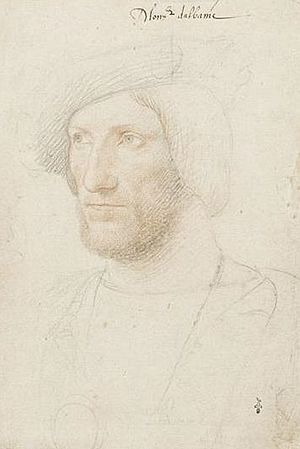
Albany arrived at Dumbarton Castle in May 1514. He came with eight ships and French soldiers. He entered Edinburgh on 26 May. In July, the Parliament confirmed his return as Duke of Albany and his role as regent.
Albany's supporters hoped he would bring stable government. Francis I of France wanted Albany to keep the Auld Alliance with France strong. Albany's first year was spent making sure his power was firm. He wanted to prevent Scotland from falling into chaos or English control.
Albany knew he needed to control the young king. This was important because his power came from acting for the king. Margaret and Angus were against Albany's plans. So, James V had to be taken away from them. Albany surrounded Stirling Castle. Margaret had to give up James and the Duke of Ross. James would not see his mother again for two years.
Margaret lost her role as regent, her income, and control of her sons. She left the court in September 1515. She fled from Linlithgow Palace to Tantallon Castle. There, she gave birth to her daughter, Lady Margaret Douglas, in Northumberland. She was very ill after the birth and long journey. She was not told about her second son Alexander's death in December 1515 until she was stronger. The Earl of Angus later made peace with Albany in 1516.
A Venetian ambassador, Sebastian Giustinian, praised Albany's success. He said Scotland "was as much under Albany's control as if he were King." In February 1517, James was moved from Stirling to the Palace of Holyroodhouse in Edinburgh. But because of a plague, he was moved to Craigmillar Castle.
At Stirling, the ten-year-old James had 20 footmen as guards. They wore his colors, red and yellow. When he went to the park, six horsemen would check the area for intruders. Poets wrote rhymes for James and taught him about being a king. James V had good teachers, including David Lyndsay and Gavin Dunbar. He learned French and Latin. However, as an adult, his French was not perfect, and he needed an interpreter for Italian.
Between 1517 and 1520, Albany was in France. He did not rule in person. Instead, his helpers, like Antoine d'Arces, governed. On 26 August 1517, Albany and Charles, Duke of Alençon signed the Treaty of Rouen. This treaty renewed the alliance between Scotland and France. It also promised a French royal bride for James V.
England asked for Albany to stay in France for four years. With Albany away, Queen Margaret returned to Scotland. She tried to become regent again but failed. Young James V was kept almost like a prisoner by Albany and his helpers. Margaret was allowed to see her son only once between 1516 and 1524.
After the Treaty of Bruges was signed between Henry VIII of England and Holy Roman Emperor, Charles V, Francis I let Albany return to Scotland. This was to make the French-Scottish alliance stronger. The Treaty of Rouen was confirmed. Madeleine of Valois was suggested as a bride for James V.
When Albany returned in November 1521, Margaret sided with him against her husband, the Earl of Angus. Albany went to Edinburgh Castle, where James V was kept. In a public ceremony, the castle keeper gave Albany the keys. Albany then gave them to Margaret, who gave them back to Albany. This showed that Albany was in charge of Scotland. Albany then accused Angus of treason in December 1521. He later sent Angus to France as a prisoner. In November 1522, Albany led an army to attack Wark Castle. But he gave up after three days because of bad weather.
Margaret Takes Control
In 1524, Albany was finally removed from power while he was in France. Margaret, with help from James Hamilton, 1st Earl of Arran and his supporters, brought James V from Stirling to Edinburgh. In August, Parliament declared that the regency was over. The 12-year-old King James was given full kingly powers early. In November, Parliament officially recognized Margaret as the king's main advisor.
Margaret's alliance with the Hamiltons upset other noble families. Henry VIII allowed the Earl of Angus, whom Albany had banished, to return to Scotland in 1524. Angus then allied with the Earl of Lennox, who was an enemy of Margaret and Arran. When Angus arrived in Edinburgh with many armed men, Margaret ordered cannons to be fired at them from Edinburgh Castle. Parliament later made Angus a Lord of the Articles and a member of the council of regency.
Angus's Control
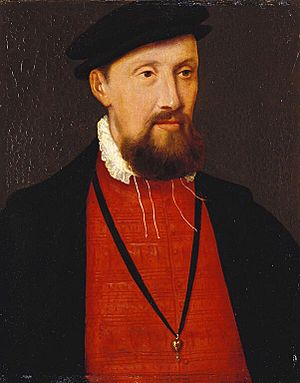
A plan was made to end the fighting among these groups. Each group would take turns hosting the young king. But the plan failed in November 1525. At the end of his time, Angus refused to give up the king. James became a prisoner of the Douglas family for the next two and a half years.
Angus again gave James V full kingly powers. He took him on justice tours and watched him closely. He gave the king many expensive gifts to try and win his favor. While James V enjoyed some parts of his captivity, he grew to dislike Angus.
Several attempts were made to free the young king. One was by Walter Scott of Branxholme and Buccleuch. He attacked the king's forces on 25 July 1526 at the Battle of Melrose, but his forces were defeated. Another attempt later that year, on 4 September at the Battle of Linlithgow Bridge, also failed to free the king from Angus.
In May 1528, James finally escaped from Angus. He fled from Edinburgh to Stirling in disguise. After meeting his mother at Stirling, James V returned to Edinburgh in July with a large army. Angus was accused of treason. He hid in Tantallon Castle until an agreement was reached. Angus was allowed to go into exile in England after giving up his castles.
James V's Own Rule
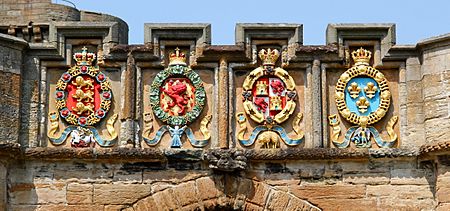
When James became king, his first action was to remove Angus. The Douglas family, except for James's half-sister Margaret, were forced to leave Scotland. James then attacked their castle at Tantallon. He also brought peace to the Border rebels and the leaders of the Western Isles.
James got advice from his nobles. He also used the help of the Duke of Albany in France and Rome. James had a team of lawyers and diplomats, like Adam Otterburn and Thomas Erskine of Haltoun. Even his pursemaster, John Tennent, was sent on a trip to England.
James increased his money by managing royal lands better. He also gained from justice, customs, and feudal rights. He gave his children born outside marriage good church positions. This brought a lot of church money into his treasury. James spent much of his wealth on building a collection of tapestries. He inherited some from his father.
James sailed to France for his first marriage. This trip also made the royal fleet stronger. In 1540, he sailed to Kirkwall in Orkney, then to Lewis. He used his ship, the Salamander. Before leaving, he made a will in Leith, knowing the journey was "uncertain." The trip was to show the king's presence and hold local courts.
Religion and the Church
The Reformation affected both Scottish and international politics. This was especially true after Henry VIII broke away from the Catholic Church. James V did not allow heresy. During his rule, some outspoken Protestants were punished. The most famous was Patrick Hamilton. He was burned at the stake as a heretic in St Andrews in 1528.
Later, the English ambassador Ralph Sadler tried to convince James to close monasteries. Sadler said James could take their money and not have to "keep sheep like a mean subject." James replied that he had no sheep. He said he could rely on the King of France. He also said it was wrong to close abbeys that had been there for many years and where God's service was kept. Sadler knew that James did raise sheep on his lands.
James got money from the church by getting Pope Clement VII to let him tax church incomes. He sent £50 to Johann Cochlaeus, a German opponent of Martin Luther, after getting one of his books in 1534. On 19 January 1537, Pope Paul III sent James a blessed sword and hat. These gifts showed his prayers that James would be strong against heresies from England. These gifts were given to James in France on 25 February 1537.
Some writers from the 1500s said James's treasurer, James Kirkcaldy of Grange, tried to stop James from punishing Protestants. He also tried to get James to meet Henry VIII in York. James and Henry talked about meeting in 1536. Pope Paul III told James not to go to England. He sent a messenger to Scotland to discuss this. Henry VIII sent his tapestries to York in September 1541 for a meeting. But James did not come. English observers saw this as a sign that Scotland was strongly allied with France and Catholicism. They thought this was because of Cardinal Beaton. This lack of meeting was seen as a reason for war.
In 1540, Irish nobles offered James the kingship of Ireland. This was another challenge to Henry VIII.
Building Projects
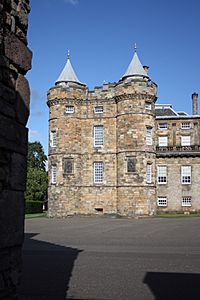
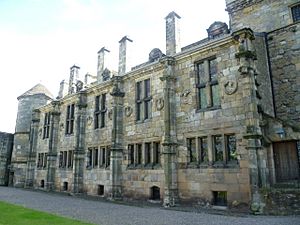
James V spent a lot of money (at least £41,000) during his reign. He greatly changed all his main homes and some smaller ones. He built new structures. The most important work was done at Falkland Palace and Stirling Castle.
Early in his rule, James began building the current Late Gothic James V Tower. This was at the north-west corner of the Palace of Holyroodhouse. It provided new royal rooms and good security. A new west front was also built.
At Linlithgow Palace, James closed the old east entrance. He made a new main entrance from the south. This included an inner gatehouse and an outer gate. The outer gate was decorated with the carved symbols of the four knightly orders James belonged to: Garter, Thistle, Golden Fleece and Saint Michael. The three-tiered, eight-sided King's Fountain was built in 1538. It was the main feature of the courtyard.
At Falkland Palace, James V added to his father's buildings. He used the French Renaissance style between 1537 and 1541. He also built a real tennis court in the garden in 1541. This court still exists today and is the oldest in the United Kingdom. James also built a new Late Gothic entrance tower in the south part. The courtyard fronts of the east and south parts, built in 1537 and 1539, are the earliest examples of Renaissance architecture in the British Isles.
The biggest building project of James V was the Royal Palace at Stirling Castle. It was built between 1538 and 1540. It has Renaissance fronts. The north, east, and south parts held the king's and queen's apartments. Work was also done at Tantallon Castle, Blackness Castle and Hermitage Castle.
Marriages
As early as 1517, a part of the Treaty of Rouen said that if the Auld Alliance between France and Scotland continued, James should marry a daughter of Francis I of France. However, by the 1520s, Francis's two surviving daughters were too weak or too young.
In 1528, the Holy Roman Emperor Charles V and the English diplomat Thomas Magnus both suggested James marry his cousin, Princess Mary. In the same year, Margaret of Austria, Charles V's aunt, suggested James marry Charles's sister, Mary of Austria. Charles V also suggested James marry his niece, Maria of Portugal.
Perhaps to remind Francis I of his promises, James V began talking about other marriages in 1529. He sent the Duke of Albany to Rome to arrange a marriage to Catherine de' Medici, the niece of Pope Clement VII. By 1533, there was talk of James marrying one of his second cousins, Christina or Dorothea, daughters of Christian II of Denmark. In 1534, Margaret of Valois-Angoulême, Francis I's sister, suggested her sister-in-law Isabella.
In December 1534, Francis I said his oldest daughter Madeleine was too sick to marry. He suggested James V marry Mary of Bourbon, daughter of the Duke of Vendôme, instead. This would fulfill the Treaty of Rouen. Again, the Duke of Albany briefly thought James might marry Christina of Denmark, and the king stopped the marriage talks. There was also a look into James marrying his former mistress, Margaret Erskine, before talks started again. In March 1536, a final contract was made for Mary of Bourbon to marry James V. She would have a dowry as if she were a French princess. Francis I confirmed the agreement by sending James the collar of the Order of Saint Michael.
Marriage to Madeleine of Valois
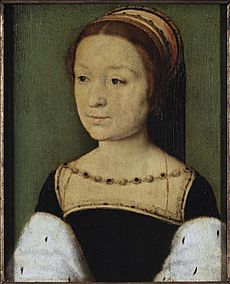
James decided to travel to France to meet his future wife himself. He sailed from Kirkcaldy on 1 September 1536. He went with several earls and lords, David Beaton, and 500 men in six ships. The Mary Willoughby was his main ship. Before leaving, James appointed six vice-regents to rule Scotland while he was away. James V would be away from Scotland for eight months. He was the first Scottish king to willingly stay away from his kingdom in almost 200 years.
Arriving at Dieppe a week later, the Scots traveled to the Duke of Vendôme's court. However, James V was not impressed by Mary of Bourbon. He then traveled south to the French court at the Château d'Amboise. There, he met Madeleine and again asked Francis for her hand in marriage. Francis was worried that Scotland's harsh climate would be bad for his daughter's already poor health. He first refused to allow the marriage. But the couple convinced Francis to reluctantly agree. The marriage contract was signed in November. Francis I gave Madeleine a dowry of 100,000 écu, and another 30,000 francs a year for James.
James V renewed the Auld Alliance. He fulfilled the Treaty of Rouen on 1 January 1537 by marrying Madeleine at Notre-Dame de Paris. James received approval from the Pope, including the Blessed sword and hat. He was given the title Defender of the Faith by Pope Paul III on 19 January 1537. This showed the Pope's hope that James would resist the path his uncle Henry VIII had taken.
After months of parties and visits, the royal couple sailed for Scotland in May 1537. They arrived at Leith on 19 May. Madeleine wrote to her father from Edinburgh on 8 June 1537. She said she was feeling better. However, a month later, on 7 July 1537, Queen Madeleine died in her husband's arms at Holyrood Palace from tuberculosis. James V wrote to Francis I to tell him what happened. He said if he were not relying on the French king to remain his "good father," he would be in even more pain. The queen was buried in Holyrood Abbey in Edinburgh.
Marriage to Mary of Guise
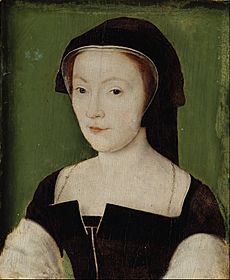
After Madeleine's death, James V looked for a second French bride. This was to further the alliance between France and Scotland. David Beaton was sent to France. He tried to convince Francis I to let James marry his only surviving daughter, Margaret. Francis offered Mary of Guise instead. Mary was the daughter of Claude, Duke of Guise. She had recently lost her husband, Louis II d'Orléans, Duke of Longueville.
David Beaton wrote to James V from Lyon in October 1537. He said Mary was "strong, well complexioned, and fit to travel." He also said her father wanted the marriage to happen quickly. The marriage contract was finalized in January 1538. James V received a dowry of 150,000 livres. If the king died first, Mary would keep her homes for life. These included Falkland Palace, Stirling Castle, Dingwall Castle and Threave Castle. She would also keep the income from several earldoms and lordships.
The proxy wedding of James V and Mary of Guise happened on 9 May 1538. It was at the Château de Châteaudun. About 2,000 Scottish lords came to attend. They arrived on ships led by Lord Maxwell. Lord Maxwell stood in for James V. Mary left Le Havre on 10 June 1538. She landed in Scotland six days later at Crail in Fife. The king officially welcomed her at St Andrews a few days later. There were shows and plays in her honor. James and Mary were married in person at St Andrews Cathedral on 18 June 1538.
James's mother, Margaret Tudor, wrote to Henry VIII in July. She said, "I trust she will prove a wise Princess." She added, "I have been much in her company, and she bears herself very honourably to me, with very good entertaining."
James and Mary had two sons. James, Duke of Rothesay was born on 22 May 1540 at St Andrews. Robert (or Arthur), Duke of Albany, was born on 12 April 1541. However, both sons died on 21 April 1541. James was almost one year old, and Robert (or Arthur) was nine days old. Mary's mother, Antoinette de Bourbon, wrote that the couple were still young and should hope for more children. The third and last child was a daughter, Mary. She was born on 8 December 1542.
Interests and Hobbies
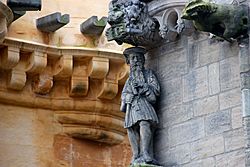
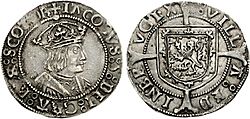
Legend says James was called "King of the Commons." This was because he sometimes traveled around Scotland in disguise. He would call himself the "Gudeman of Ballengeich." 'Gudeman' means 'landlord' or 'farmer.' 'Ballengeich' was the name of a road near Stirling Castle, meaning 'windy pass' in Gaelic. One old song, The Jolly Beggar, is thought to be about his adventures.
James also loved playing the lute. In 1562, Sir Thomas Wood said James had "a singular good ear." He could "sing that he had never seen before" (meaning he could sight-read music). But his voice was "rawky" and "harske." At court, James had a group of Italian musicians called Drummond. A musician and diplomat from the Duke of Milan, Thomas de Averencia de Brescia, joined them in 1529/30. He was likely a lutenist.
Historian Andrea Thomas explains that there was loud music for ceremonies. There was also quieter music for private times or worship. This quieter music included a group of viols played by four Frenchmen. It is likely that David Peebles wrote music for James V. It is also probable that the Scottish composer Robert Carver worked for the king, though there is no clear proof.
James supported poets and writers. He helped William Stewart and John Bellenden. Bellenden was the son of James's nurse. He translated the Latin History of Scotland by Hector Boece into verse and prose. Sir David Lindsay of the Mount, the Lord Lyon and a diplomat, was a very active poet. He created a play at Linlithgow Palace in 1540. This is thought to be a version of his play The Thrie Estaitis.
James also caught the attention of writers from other countries. The French poet Pierre de Ronsard, who had been a page to Madeleine of Valois, praised him greatly: "His royal bearing, and vigorous pursuit of virtue, of honour, and love's war, this sweetness and strength illuminate his face, as if he were the child of Venus and Mars."
When James married Mary of Guise, Giovanni Ferrerio dedicated a new book to them. Ferrerio was an Italian scholar who had been in Scotland. His book was On the True Significance of Comets against the Vanity of Astrologers.
Like Henry VIII, James hired many foreign artists and craftspeople. He wanted to make his court more impressive. Robert Lindsay of Pitscottie listed their jobs: "He filled the country with all kinds of craftsmen from other countries, like Frenchmen, Spaniards, Dutchmen, and Englishmen. They were all skilled craftsmen, each in their own field. Some were gunners, carpenters, carvers, painters, masons, smiths, armor-makers, tapestry-makers, embroiderers, tailors, skilled surgeons, apothecaries, and all other kinds of craftsmen to decorate his palaces."
One new technology was a special mill for polishing armor at Holyroodhouse, next to his mint. The mill had a 32-foot long pole driven by horses. Mary of Guise's mother, Antoinette of Bourbon, sent him an armor-maker. This armor-maker made steel plates for James's jousting saddles in October 1538. He also delivered a skirt of plate armour in February 1540. In the same year, for his wife's coronation, James personally designed fireworks. His master gunners made them. His goldsmith John Mosman updated the crown jewels for the event.
When James stopped the spread of mean songs about Henry VIII, Henry sent Fulke ap Powell to thank him. He also arranged to send a lion for James's collection of exotic animals.
War with England and Death
The death of James's mother in 1541 removed any reason for peace with England. War soon began. At first, the Scots won a battle at Haddon Rig in August 1542.
The Imperial ambassador in London, Eustace Chapuys, wrote on 2 October that Scottish messengers would not agree to a meeting between James and Henry VIII in England until Mary of Guise gave birth. Henry would not accept this. He gathered his army against Scotland.
James was with his army at Lauder on 31 October 1542. He hoped to invade England, but his nobles were unwilling. He returned to Edinburgh. On the way, he wrote a letter to his wife from Falahill, saying he had been sick for three days. On 24 November, his army lost badly at the Battle of Solway Moss.
After a few days at Linlithgow Palace with Queen Mary, who was very pregnant, James traveled to Falkland Palace on 6 December. He soon became ill.
Even though James V's army lost at Solway Moss, it was not a personal shame for the king. He was not there. It was also not because his nobles were disloyal. In fact, James had strong support for his war plans. In early December, he had plans to restart the fight with England.
James was dying at Falkland when news arrived from Linlithgow. The queen had given birth to a daughter. According to John Knox, when James heard about his daughter's birth, he said, "It cam wi' a lass, and it will gang wi' a lass." This meant "It began with a girl and it will end with a girl." This could refer to the Stewart dynasty coming to the throne through Marjorie Bruce, daughter of Robert the Bruce. The saying might have meant he believed his new daughter Mary would be the last Stewart monarch. However, the last Stewart monarch was indeed a female: Anne, Queen of Great Britain.
James V died at Falkland Palace on 14 December 1542, at age 30. The king had been sick several times in the past ten years. He was ill in 1533, 1534, 1536, and 1540. In 1540, he wrote to his wife saying he had been as sick as ever but was now better. His immune system likely had not fully recovered, as he was sick again in November 1542. It is thought that James V died from cholera or dysentery. It was not from shame or sadness about the Battle of Solway Moss.

James was followed by his baby daughter, Mary, Queen of Scots. On 7 January 1543, the king's body was taken from Falkland to the Forth ferry at Kinghorn. Then it was taken to Edinburgh, with a funeral procession. Cardinal Beaton, the Earls of Arran, Argyll, Rothes, Marischal, and other nobles were there. James V was buried on 8 January at Holyrood Abbey. He was buried next to his first wife, Madeleine, and his two sons. A stone tomb was built. On it, Andrew Mansioun carved a lion, a crown, and an 18-foot-long message in Latin letters. Money was given to the poor of Edinburgh who were at the king's funeral service. During the Rough Wooing, English armies damaged Holyrood Abbey in 1544 and 1547. James V's tomb was destroyed.
James was the last monarch to die in Scotland until 8 September 2022. That is when Queen Elizabeth II died at Balmoral Castle in Aberdeenshire, 480 years later. Days later, her body was carried through Edinburgh. This was the first time a royal procession had passed through the city since James V's burial.
Children
Children with Madeleine of France
| Name | Birth | Death | Notes |
|---|---|---|---|
| No children | |||
Children with Mary of Guise
| Name | Birth | Death | Notes |
|---|---|---|---|
| James, Duke of Rothesay | 22 May 1540 | 21 April 1541 | |
| Arthur or Robert, Duke of Albany | 12 April 1541 | 20 April 1541 | |
| Mary, Queen of Scots | 8 December 1542 | 8 February 1587 | Married Francis II of France, then Henry Stuart, Lord Darnley (had a son, James VI and I), then James Hepburn, 4th Earl of Bothwell. |
Other Children
| Name | Birth | Death | Notes |
|---|---|---|---|
| By Elizabeth Shaw | |||
| James Stewart, Commendator of Kelso and Melrose | c. 1529 | 1557 | His daughter, Marjorie, married his half-nephew. |
| By Margaret Erskine | |||
| James Stewart, 1st Earl of Moray | c. 1531 | 23 January 1570 | A church leader; later ruled Scotland for his nephew James VI. Married Agnes Keith, Countess of Moray, and had children. |
| By Elizabeth Stewart | |||
| Adam Stewart, Prior of Perth | ? | 20 June 1575 | Married Janet Ruthven and had children. |
| By Christine Barclay | |||
| James Stewart | ? | ? | |
| By Elizabeth Carmichael | |||
| John Stewart, Commendator of Coldingham | c. 1531 | November 1563 | Married Jean Hepburn and had children. |
| By Elizabeth Bethune | |||
| Jean Stewart | c. 1533 | 7 January 1587/88 | Married Archibald Campbell, 5th Earl of Argyll. |
| By Euphame Elphinstone | |||
| Robert Stewart, 1st Earl of Orkney and Lord of Zetland | c. 1533 | 4 February 1593 | Married Jean Kennedy and had children. |
| Unnamed child | ? | ? | Died as a child. |
James V in Stories and Art
James V has been shown in historical novels, poems, short stories, and one famous opera. Here are some examples:
- The Lady of the Lake by Walter Scott. This is a Romantic poem set in the Trossachs. James appears in disguise. The poem was very popular in the 1800s. James also appears in Scott's Tales of a Grandfather.
- "Johnnie Armstrong", a traditional song. It tells the story of Scottish raider Johnnie Armstrong. King James V captured and hanged him in 1530.
- La donna del lago, an opera based on Scott's poem. Sung in Italian, James V appears as "Giacomo V".
- The Rough Wooing by Maurice Walsh. This novel is about Scotland after the Battle of Flodden. It covers events up to 1514. Margaret Tudor, "Boy-King" James V, and Archibald Douglas, 5th Earl of Angus, are important characters.
- The Royal Road to Fotheringay by Jean Plaidy. James is the main character. He is shown as an "adventure-loving" person.
- The Sea-Hawk by Rafael Sabatini. This novel shows Orkney, Edinburgh, and Normandy in the 1500s. James V appears more than once.
- The Spanish Bride by Georgette Heyer. This novel shows events just before and after James V's death. James V, Mary of Guise, and David Beaton are important characters.
Ancestors
| Ancestors of James V of Scotland | |||||||||||||||||||||||||||||||||||||||||||||||||||||||||||||||||||||||||||||||||||||||||||||||||||||||||||||||||||||||||||||||||||||||||||||||||||||||||||||||||||||||||||||||||||||||||||||||||||||||||||||||||||||||||||||||||||||||||||||||||||||||||||||||||||||||||||||||||||||||||
|---|---|---|---|---|---|---|---|---|---|---|---|---|---|---|---|---|---|---|---|---|---|---|---|---|---|---|---|---|---|---|---|---|---|---|---|---|---|---|---|---|---|---|---|---|---|---|---|---|---|---|---|---|---|---|---|---|---|---|---|---|---|---|---|---|---|---|---|---|---|---|---|---|---|---|---|---|---|---|---|---|---|---|---|---|---|---|---|---|---|---|---|---|---|---|---|---|---|---|---|---|---|---|---|---|---|---|---|---|---|---|---|---|---|---|---|---|---|---|---|---|---|---|---|---|---|---|---|---|---|---|---|---|---|---|---|---|---|---|---|---|---|---|---|---|---|---|---|---|---|---|---|---|---|---|---|---|---|---|---|---|---|---|---|---|---|---|---|---|---|---|---|---|---|---|---|---|---|---|---|---|---|---|---|---|---|---|---|---|---|---|---|---|---|---|---|---|---|---|---|---|---|---|---|---|---|---|---|---|---|---|---|---|---|---|---|---|---|---|---|---|---|---|---|---|---|---|---|---|---|---|---|---|---|---|---|---|---|---|---|---|---|---|---|---|---|---|---|---|---|---|---|---|---|---|---|---|---|---|---|---|---|---|---|---|---|---|---|---|---|---|---|---|---|---|---|---|---|---|---|---|---|
|
|||||||||||||||||||||||||||||||||||||||||||||||||||||||||||||||||||||||||||||||||||||||||||||||||||||||||||||||||||||||||||||||||||||||||||||||||||||||||||||||||||||||||||||||||||||||||||||||||||||||||||||||||||||||||||||||||||||||||||||||||||||||||||||||||||||||||||||||||||||||||
See also
 In Spanish: Jacobo V de Escocia para niños
In Spanish: Jacobo V de Escocia para niños


